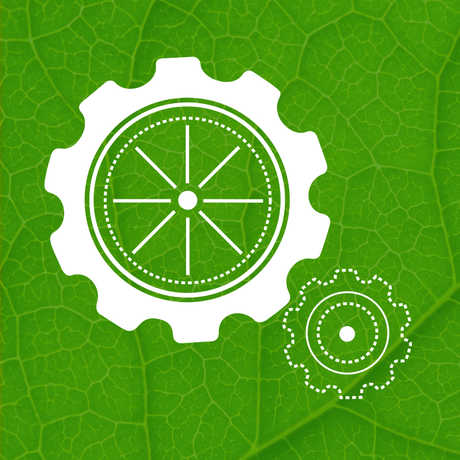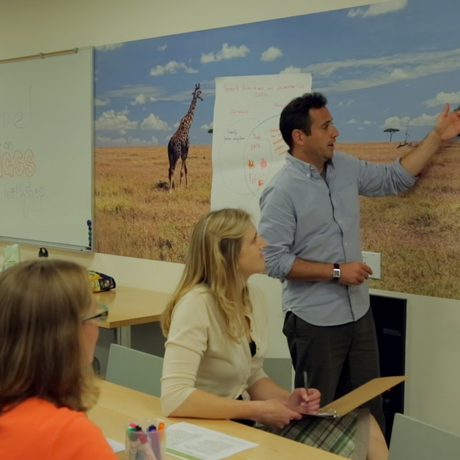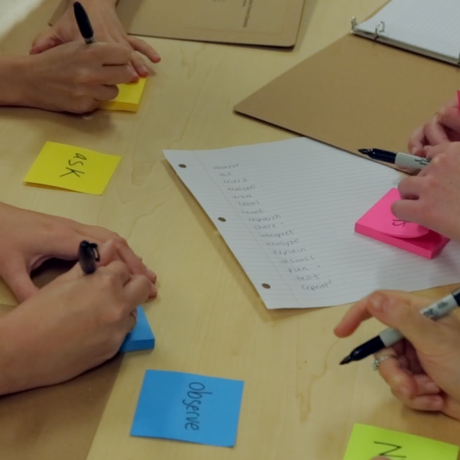
The Practices Circus is an introductory activity that builds familiarity with the Science and Engineering Practices of the NGSS. Participants will visit hands-on stations with sample activities and try to identify the main practice highlighted in each one. Group discussion will draw out key messages such as the interconnection of the practices and the idea of intentionality.
Watch the video above to get an overview, and use the detailed lesson plan below to lead this professional development activity for your team of educators.
Learning Goals
Participants in this activity will
- get more familiar with the Science and Engineering Practices.
- see simple examples of classroom activities connected to the practices.
- think about how one activity can be focused on different practices, depending on the educator’s intentions.
Approximate Time
- Full version (recommended): 50 minutes
- Split version: two 30 minute sessions
- Abbreviated version: one 30 - 40 minute session
Materials
- Practices Circus chart hand out (1 per participant)
- Station instruction cards
- Signs numbered 1-7
- List of station instructions hand out (1 per participant)
- Station materials:
- station 1: samples of two different soils; water; small plates or petri dishes; eye droppers; beakers or other containers for the soil and water
- station 2: fresh flowers; tray; tools for dissecting flowers (such as scissors, picks, knives or scalpels)
- station 3: water; salt; ice; beakers or other containers for the water and ice
- station 4: hard boiled eggs; small plate or napkin; knife
- station 5: warm water; sugar; yeast; beaker or cup; spoon
- station 6: calculator
- station 7: plastic bottle; eyedropper; water. (This video briefly describes the set-up)
- Practices Circus chart key (for facilitator only)
Prepare
- Gather and prepare materials for the stations
- If you have a smaller group (15 or fewer participants), prepare enough for one of each station.
- If you have a larger group, we recommend planning for duplicate stations (two copies of station 1, two copies of station 2, etc.) to avoid crowding at the stations.
- Print the station instruction cards.
- Set up the stations and instruction cards around the room.
- Draw the Practices Circus chart on the board.
Background for Facilitators
The Practices Circus is an introductory activity that builds familiarity with the Science and Engineering Practices (SEPs) of the NGSS. Participants will visit stations with sample activities and try to identify the main practice highlighted in each one. The stations are fairly simple, so this is just a surface level look at the practices, but it’s an excellent starting point to build a foundation for deeper exploration later on.
There are a few key points that should come out of this experience and discussion. Participants start to recognize the interconnection of the practices. As they try to identify the main practice at each station, they see that there are often other practices present that support or lead into each other. Practices never really exist in isolation.
Another message is the importance of intentionality. For example, when we ask students to graph their data, we should have a clear intention as to why they are doing this. Is the purpose of the graph to analyze and interpret the data? Or is the purpose to communicate something about the data to someone else? Don’t just make graphs out of habit; think about why we’re doing it and what students are learning from it. Intentionality is key to many aspects of the NGSS.
Some of the stations in this activity are fairly clear as to which practice is targeted, but others are deliberately ambiguous to spark discussion. During the group discussion, don’t be afraid to let teachers disagree about their answers. If they can’t decide between two practices, ask how they could shift the activity to intentionally target one or the other.
Note that if this activity is the first time participants are encountering the practices, it can be a bit overwhelming. Participants will be most successful if they have at least been introduced to the practices beforehand.
Full Version
Part 1. Introduction and Directions (10 minutes)
- If this is the first time your participants are encountering the practices (not recommended!), take a few moments to introduce them. Even if they have seen the practices before, briefly review to have them fresh in mind.
- Orient participants to the stations that are set up around the room. Explain that they will work in pairs and can visit the stations in any order.
- Emphasize that the purpose is not to do the activities. Of course, they can be hands-on and play with the materials (and should—it’s more fun that way!); however, they should keep in mind that their task is to read the instructions on each station card and identify the practice best represented by the underlined portion of the prompt.
- Alert the participants that some prompts clearly target one practice, and some are more vague in order to spark thoughtful discussion. Additionally, some stations might include multiple practices in different parts of the instructions, but they should focus on the underlined portion of text and identify the one practice best represented by that phrase.
- Distribute the “Practices Circus chart hand out” and tell participants that they will have ~20 minutes to visit the stations.
- Instruct participants that after they finish exploring, they should put a tally mark on the white board to vote for the one practice they identified at each station. These tallies will be a starting point for the class discussion.
Part 2. Station Rotation (20 minutes)
- Walk around and chat with pairs as they visit the stations. Help to clarify any confusion and remind them of their task.
- As the end of the 20 minutes approaches, remind pairs to add their tally marks to the board when they are done rotating through the stations.
Part 3: Group Discussion (20 minutes)
- Distribute the “list of station instructions” handout for participants to refer to during the discussion.
- Go through the stations one by one and discuss the results.
- For each station, start with the chart on the board and identify where the most tally marks appear.
- Ask for a volunteer to explain why they think that station represents that particular practice.
- If votes are split, have participants share their reasoning for each main option.
- To keep the discussion moving, try not to get hung up on long debates about the outliers; aim to focus on the two or three practices with the most tally marks.
- Keep in mind that certain stations will demonstrate how a single activity can be related to different practices depending on the goal of the activity—these stations are meant to highlight the importance of intentionality. Don’t be afraid to let participants disagree. If the group is divided between two practices, reframe the discussion by asking them how they could shift the language of the prompt to target it more clearly to one practice or the other. Encourage them to keep this clarity of purpose in mind when they are giving instructions to their own students.
- Use the summary of the targeted practices below to guide your discussion (or use the Practice Circus chart key):
- Station 1A: Planning and Carrying Out Investigations
- Station 1B: If the purpose of the chart is to figure out what the data shows, this is Analyzing and Interpreting Data. If the purpose of the chart is to share your conclusions about the data with other people, then this is Obtaining, Evaluating, and Communicating Information.
- Station 2: If the purpose of the drawing is to develop your understanding (your mental model) of the flower’s structure, this is Developing and Using Models. If the purpose is to share your understanding of the flower’s structure with other people, then this is Obtaining, Evaluating, and Communicating Information.
- Station 3: Constructing Explanations and Designing Solutions
- Station 4: Developing and Using Models
- Station 5: Asking Questions and Defining Problems
- Station 6A: Analyzing and Interpreting Data
- Station 6B: Using Mathematics and Computational Thinking
- Station 7: Engaging in Argument from Evidence
- Aim to leave participants feeling pretty clear about which one or two practices each station represents. However, be careful not to make participants feel bad if their initial ideas were different. In fact, having some different opinions on the table will make the discussion more interesting. Throughout the discussion, ask participants to share their reasoning and encourage them to listen thoughtfully to each other’s ideas. Focus on thoughtful reasoning rather than on who is right or wrong.
- Wrap up by asking participants to reflect on how this experience impacted their understanding of the Science and Engineering Practices. You can do this as a think/pair/share, a written reflection, or any other format that works for you.
Make sure participants leave the discussion with:
- a clear idea of which SEP was best represented at each station.
- an understanding of how a single activity can yield different outcomes, based on the goal of the activity.
Split Version
If you need to split this activity to fit into shorter sessions, we suggest breaking it up as follows:
- Session 1 [30 minutes]: Do Parts 1 (Introduction) and 2 (Station Rotation) as described above. Before you erase the board at the end of the session, take a photo or otherwise document the chart with the participants’ tally marks.
- Session 2 [30 minutes]: Start by giving participants the “list of station instructions” handout and display the chart with their tally marks from the previous session. Give them a few minutes to refresh their memory by reviewing the stations and chatting with their partners about the practices they identified. Then spend the remainder of the time doing Part 3 (Group Discussion) as described above.
Abbreviated Version
If you need to shorten this activity to fit the time you have available, we suggest using fewer stations. This will allow for a shorter time spent rotating (10 – 15 minutes), as well as a shorter discussion (10 – 15 minutes). Be careful not to shorten the discussion too much since that is where the important meaning-making happens! Also keep in mind that with this approach, participants will not see examples of all the practices.
If you choose to take this approach, we recommend using the following stations:
- Soils A and B
- Ice Melts
- Yeast
- Cartesian Diver

NGSS Demystified
This training toolkit will prepare you to lead PD for other educators.
Browse all of the videos at once.

